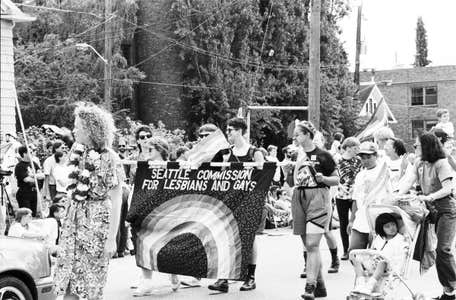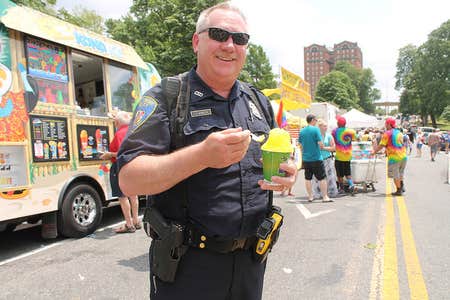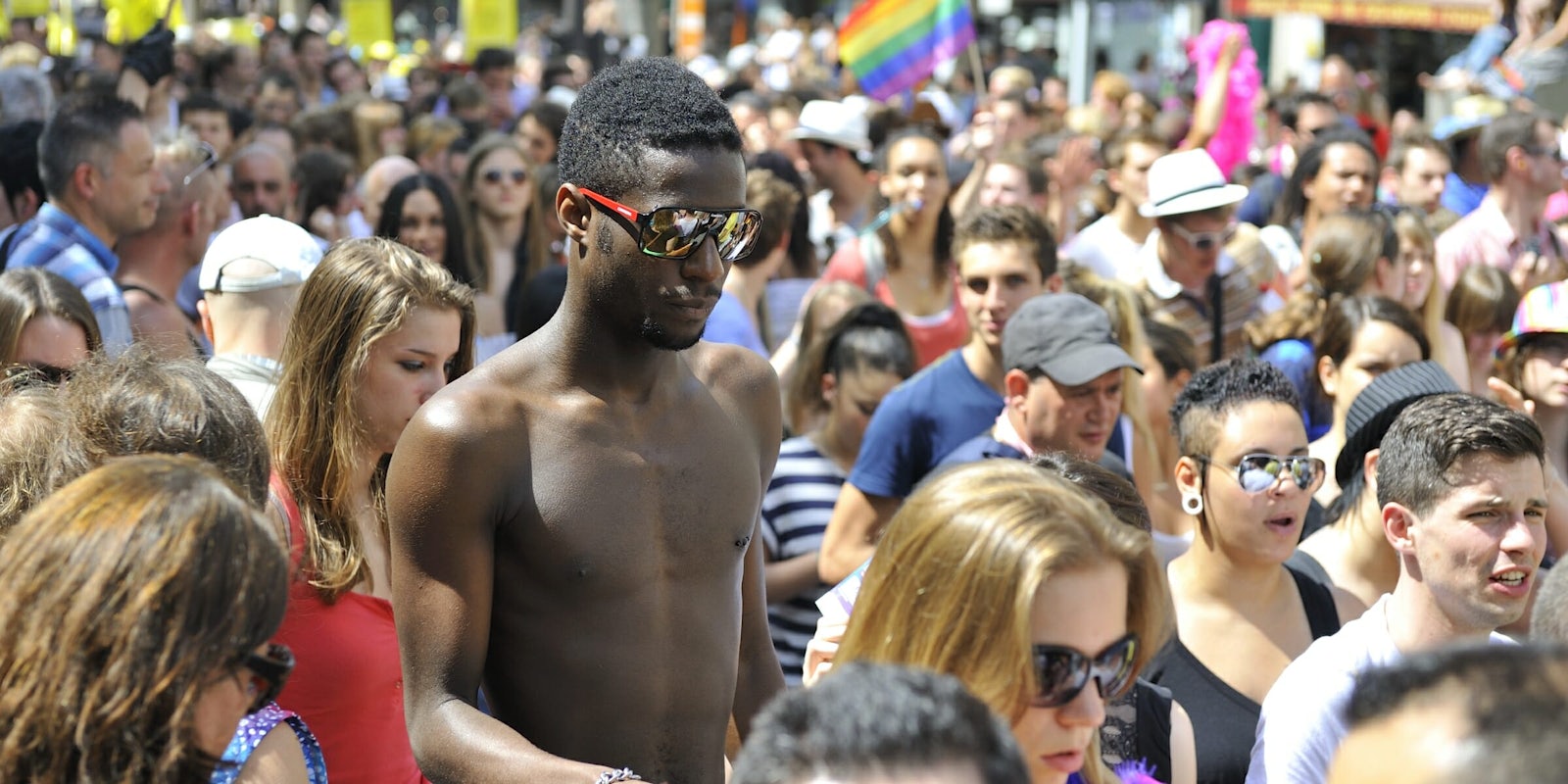Opinion
My girlfriend and I were hanging out in Asbury Park in New Jersey over the weekend, just one day before Jersey Pride. Rainbow flags adorned the boardwalk as to be expected—Asbury is one of New Jersey’s queerest beaches after all—but those familiar LGBTQ colors weren’t the only flags around town. One shop selling rainbow flags had plenty of transgender and bisexual flags available for sale too, and storefronts here and there had the trans flag on display.
That took me by surprise. My first Pride was in 2016, and during New York City’s iconic march through Manhattan, I only remember seeing a couple trans flags from a float for the city’s LGBTQ center, aptly called the Center. I went again with my girlfriend last year, and visibility had increased a little, but trans rights weren’t exactly something most Pride participants wore on their sleeve (or, more pertinently, had painted on their bare arm).
But something is starting to change. The trans military ban hit in late July, and earlier this year, the Trump White House vowed to roll back anti-discrimination protections for transgender healthcare. The LGBTQ community’s most vulnerable population was visibly under direct attack, and queer people of all stripes rallied to our defense. After all, an assault on one letter was an assault on every single one.
Now it’s Pride Month again, and while it’s nice to see a business or two sporting a trans flag, I’m left wondering, is this acceptance growing fast enough? If it’s not the Trump administration stripping us of our rights, what will make Pride return to its radical roots?
Rethinking Pride

Somewhere along the line, Pride changed in America. Parades went from radical marches for solidarity to all-day parties swarmed with straight people that want to hang out, dress in rainbow colors, and get plastered while cheering on Ariana Grande music blasting from a TD Bank float.
To understand how we got here—or rather, why we did—it’s important to consider Pride’s history. Pride began in 1970 in New York City, one year after the Stonewall riots kicked off the LGBTQ movement in Greenwich Village. When it first began, Pride “was solely a political demonstration to voice LGBT demands for equal rights and protections,” the Human Rights Campaign notes, but by 1991, Pride changed into “a celebration of queer life and sexuality in addition to a political and social demonstration.”
But also in the ’90s, Pride slowly evolved (or devolved) from an event by and for the queer community into one led by corporations bankrolling rainbow flag floats in exchange for advertising. In particular, New York City’s Pride and other parades in major cities started receiving corporate sponsors, according to MarketWatch. I can’t blame the march’s leaders for accepting the sponsorships at the time, as visibility was more important than ever; the AIDS crisis peaked during the late 1980s and early ’90s, and the epidemic’s sheer impact on the queer community cannot be overstated. Friends, lovers, and family members passed away, one after the other, as the world looked on apathetically.
But corporations’ role at Pride has since skyrocketed, and clearly, they’ve overstayed their welcome. Queer writer Krista Burton says that her first Pride in 2003 already had its political flame snuffed out, with “righteous fury” replaced by “nearly naked gay men [throwing] glitter sunscreen into the crowd while Nelly’s ‘Hot in Herre’ blared.”
She suggests Pride’s inclusiveness toward straight people is its undoing, leaving the queer community with a parade that’s just a shadow of its past.
“Who is Pride really for these days? Queers who are proud to be queers, of course,” Burton says. “But it’s yet another place that straight white people now feel 100 percent welcome, even though they feel perfectly at home in any public space.”

READ MORE
- Here’s what it really means to be asexual
- What exactly is intersectionality? A complete history of the term
- Trans and nonbinary people explain what gender dysphoria feels like
It’s not just that Pride is welcoming toward straight allies. It’s expensive, too. MarketWatch estimates that New York City Pride March received $1.7 million in sponsorships for 2016 alone. Meanwhile, Wells Fargo bankrolled around 60 different pride celebrations across the U.S. in 2017, spending $50 million in total. Pride is enormous these days, and that means parades have to be advertiser-friendly to court donors, sacrificing “politics” for some good-natured, rainbow-flag-touting fun.
But the Stonewall riots weren’t corporate-sponsored marches through Greenwich Village. Pride started as a riot, one led by trans women of color throwing rocks at police, and its existence is inherently political. When Pride and Pride Month embrace that family-friendly message of “Pride for everyone,” Pride itself ceases to exist as an affront to heteronormativity’s toll on the queer community. It’s just a party with gay dressing, where straight people flock into town, get plastered, and cops watch over the queer community to make sure any protests that pop up don’t interfere with all the fun.
https://twitter.com/moonenby/status/1003345190416011264
If you're anti-trans, you have NO business being at #Pride. At all. None!
— 🏳️⚧️ TransEthics™🧜🏻♀️ #BlackTransLivesMatter (@TransEthics) June 3, 2018
It was Black #Trans Women and Trans Women of Color who started the riots that became Pride. If you don't respect trans people, GET THE FUCK OUT! pic.twitter.com/sRaBz4sI17
https://twitter.com/cheruppi/status/1002738289718190080
https://twitter.com/marianastrensch/status/1003963772069822464
No cops are Pride #PrideMonth pic.twitter.com/hQNc1j3JWT
— Chicago DSA 🌹 (@ChicagoDSA) June 1, 2018
https://twitter.com/Alysonesque/status/1003691700202586115
Pride is cis, white, and corporate these days because it’s safe. One Pew Research Center study from 2016 shows 87 percent of Americans know someone who is gay or lesbian, but only 30 percent know someone who is transgender. Meanwhile, a May 2017 Gallup study revealed that 48 percent of Americans think transgender people should use the restroom that corresponds with their gender assigned at birth, not their gender identity. It’s much harder to get Miller Lite or Microsoft to back a float calling for trans rights when most Americans don’t even know a trans person, let alone still feel queasy about trans acceptance.
But it’s trans people who are directly under attack by the current White House administration, and it’s queer people of color who are impacted the most by violence against the queer community. For them, Pride must be political because their very existence has been politicized.
Putting the LGBTQ community’s most marginalized communities front-and-center may not be exciting to corporations. But Pride isn’t about opening up a new debit card with Bank of America; it’s about queer people being heard, seen, and loved. Pride Month belongs to us—the queer us—and it’s time straight people start acting like guests, not hosts, to the celebration.
